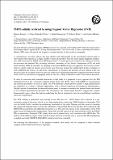Por favor, use este identificador para citar o enlazar a este item:
http://hdl.handle.net/10261/89069COMPARTIR / EXPORTAR:
 SHARE
BASE SHARE
BASE
|
|
| Visualizar otros formatos: MARC | Dublin Core | RDF | ORE | MODS | METS | DIDL | DATACITE | |

| Título: | SMOS salinity retrieval by using Support Vector Regression (SVR) |
Autor: | Katagis, Thomas; Fernández-Prieto, Diego; Marconcini, Mattia; Sabia, Roberto CSIC; Martínez, Justino CSIC ORCID | Fecha de publicación: | 11-abr-2013 | Editor: | European Geosciences Union | Citación: | Geophysical Research Abstracts 15: EGU2013-11470 (2013) | Resumen: | The Soil Moisture and Ocean Salinity (SMOS) mission was launched in November 2009 within the framework of the European Space Agency (ESA) Living Planet programme. Over the oceans, it aims at providing Sea Surface Salinity (SSS) maps with spatial and temporal coverage adequate for large scale oceanography. A comprehensive inversion scheme has been defined and implemented in the operational retrieval chain to allow proper SSS estimates in a single satellite overpass (L2 product) from the multi-angular brightness temperatures (TBs) measured by SMOS. Such SMOS operational L2 salinity processor minimizes the difference between the measured and modeled TBs, including additional constraints on Sea Surface Temperature (SST) and wind speed auxiliary fields. In particular, by adopting a maximum-likelihood Bayesian approach, the inversion scheme retrieves salinity under an iterative convergence loop. However, despite the implemented iterative technique is well established and robust, it is still prone to limitations; for instance, the presence of local minima in the cost function cannot be excluded. Moreover, previous studies have demonstrated that the background and observational terms of the cost function are not properly balanced and this is likely to introduce errors in the retrieval procedure. In order to overcome such potential drawbacks, in this study it is proposed a novel approach for the SSS estimation based on the >-insensitive Support Vector Regression (SVR), where both SMOS L1 measurements and auxiliary parameters are used as input. The SVR technique already proved capable of high generalization and robustness in a variety of different applications, with a limited complexity in handling the learning phase. Notably, instead of minimizing the observed training error, it attempts to minimize the generalization error bound so as to achieve generalized performance. For this purpose, the original input domain is mapped into a higher dimensionality space (where the function underlying the data is supposed to have increased flatness) and linear regression is performed. The SVR training is performed using suitable in situ SSS data (i.e. ARGO buoys data) collected in a representative region of the ocean. So far, in situ data coming from a match-up ARGO database in November 2010 over the South Pacific constitute the preliminary benchmark of the study. Ongoing activities point at extending this spatial and temporal frame to assess the robustness of the method. The in situ data have been collocated with SMOS TB measurements and additional parameters (e.g., SST and wind speed) in the learning phase of the SVR under various training/testing configurations. Afterwards, the SSS regression has been performed out of the SMOS TBs or emissivities. Estimated SVR salinity fields are in general (very) well correlated with ARGO data. The analysis of the different impact of the various features has been performed once a rigorous data filtering/flagging is applied, and misfit (SSSSVR-SSSARGO) statistics have been computed. For assessing the effectiveness of the proposed method, final results will be compared to those obtained using the official SMOS SSS retrieval algorithm | Descripción: | European Geosciences Union General Assembly 2013, 7-12 April, Vienna, Austria | Versión del editor: | http://meetingorganizer.copernicus.org/EGU2013/posters/12463 | URI: | http://hdl.handle.net/10261/89069 | Identificadores: | e-issn: 1607-7962 |
| Aparece en las colecciones: | (ICM) Comunicaciones congresos |
Ficheros en este ítem:
| Fichero | Descripción | Tamaño | Formato | |
|---|---|---|---|---|
| Katagis_et_al_2013.pdf | 38,73 kB | Adobe PDF |  Visualizar/Abrir |
CORE Recommender
Page view(s)
189
checked on 22-may-2024
Download(s)
65
checked on 22-may-2024
Google ScholarTM
Check
Este item está licenciado bajo una Licencia Creative Commons

